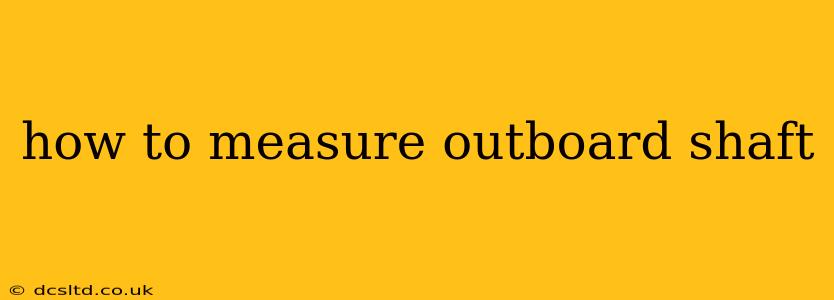Measuring your outboard motor's shaft length is crucial for various reasons, from determining the correct propeller to ensuring proper installation and performance. Getting it wrong can lead to inefficient operation, damage to your boat, or even dangerous situations. This guide will walk you through the process, clarifying common misconceptions and addressing frequently asked questions.
What is Outboard Shaft Length?
Outboard shaft length refers to the distance from the top of the cavitation plate (the flat plate at the bottom of the outboard) to the top of the anti-ventilation plate (the top of the lower unit). It's a critical specification that dictates how deep your outboard sits in the water, directly affecting performance and efficiency.
How to Measure Your Outboard Shaft Length
The most accurate method involves direct measurement using a tape measure. Here's a step-by-step guide:
- Safety First: Ensure the outboard is securely mounted and the engine is turned off. Never attempt to measure a running outboard.
- Locate the Cavitation Plate: This is the flat plate at the bottom of the lower unit of your outboard motor.
- Locate the Anti-Ventilation Plate: This plate is located at the top of the lower unit, often near the point where the lower unit connects to the midsection.
- Measure Vertically: Using a tape measure, measure the vertical distance between the top of the cavitation plate and the top of the anti-ventilation plate.
- Record the Measurement: Note down the measurement in inches. Common shaft lengths are expressed in inches (e.g., 15", 20", 25").
What if my outboard is already installed?
If your outboard is already installed on your boat, you can still measure the shaft length. You may need to use a slightly different approach, possibly using a flexible measuring tape to reach the cavitation plate from above. Make sure the boat is level to get the most accurate reading.
How to Interpret the Measurement
Once you have the measurement, you'll have the shaft length of your outboard. This number is crucial when ordering parts, especially propellers, or when considering an outboard replacement. Always double-check the measurement before ordering any components.
Why is Accurate Measurement Important?
Accurate measurement is paramount for:
- Optimal Propeller Selection: The shaft length directly impacts the propeller selection. Using an incorrect propeller can reduce fuel efficiency, decrease performance, and potentially damage your engine.
- Proper Installation: Incorrect shaft length can lead to improper installation, causing issues with the engine's trim and causing damage to your boat's transom.
- Safe Operation: Incorrect shaft length can lead to ventilation (the propeller coming out of the water), impacting steering control and performance. This can be especially dangerous at higher speeds.
What are the common outboard shaft lengths?
Common shaft lengths include 15", 20", 25", and even longer lengths for larger boats and specific applications. The specific shaft length needed depends on the size and type of boat.
How do I know what shaft length I need for my boat?
Determining the correct shaft length for your boat depends on several factors including the boat's hull design, size, and the type of outboard motor. Consulting your boat's manufacturer's specifications or a marine professional is recommended.
Can I adjust the shaft length on my outboard?
No, the shaft length on an outboard motor is fixed and cannot be adjusted. If you need a different shaft length, you would need to replace the entire lower unit.
By carefully following these steps, you can accurately measure your outboard shaft length and ensure the proper function and longevity of your outboard motor. Remember, when in doubt, consult a qualified marine mechanic.
